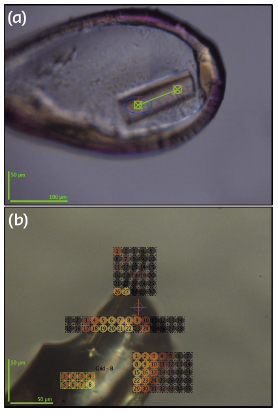- Home
- Users & Science
- Scientific Documentation
- ESRF Highlights
- ESRF Highlights 2014
- Enabling technologies
- MXCuBE2 defines a new paradigm in macromolecular crystallography beamline control
MXCuBE2 defines a new paradigm in macromolecular crystallography beamline control
Macromolecular crystallography (MX) beamlines have been undergoing an increasing evolution in automation, with constant improvements in robotics for sample handling, development of high accuracy multiaxis diffractometers, and faster and more sensitive X-ray detectors based on pixel technologies. This evolution has resulted in both an increase in the productivity and an improvement in the quality of diffraction data collected. Moreover, the advent of microfocus beamlines has made it possible to collect data from microcrystals or from the best diffracting part of any crystal. However, developments in instrumentation have not been the only driving force behind the increase in scientific productivity of MX beamlines: The simultaneous development of laboratory information management systems (LIMS) [1], automatic pipelines for data collection [2] and reduction [3], and software for beamline control has also been an essential contributor as it has allowed researchers to perform increasingly complex experiments and to link these both to exhaustive metadata descriptions and to automated data analysis.
MXCuBE (Macromolecular Crystallography Customised Beamline Environment), is a beamline control graphical user interface (GUI) for MX experiments [4] that was initially developed at the ESRF. The first version of MXCuBE was released in 2005, and since then it has become the preferred data-acquisition software for structural biologists at many synchrotron sites, providing a platform for modern high-throughput MX that also allowed users to carry out experiments remotely. In particular, the MXCuBE GUI provided the user with an intuitive means of interacting with beamline components by using graphical icons and visual indicators rather than text-based interfaces. MXCuBE2 is a completely upgraded version of MXCuBE, its development and recent deployment has been driven by the new requirements of next-generation MX experiments at synchrotron sources.
MXCuBE2 is built on a level of hardware abstraction that permits its adaptation to any kind of hardware environment and its interfacing with a variety of low-level control systems, thus making it compatible with most components of any synchrotron-based MX facility. Like its predecessor, MXCuBE2 offers users the same look-and-feel to its interface despite controlling different hardware, and it allows users to drive experiments from a single module that controls sample handler, diffractometer, detector and all other beamline components. In this manner, it allows users to focus on samples and experiments, without having to have a specific knowledge of how the hardware is going to carry out the instructions. Compared to that of MXCuBE, the appearance of MXCuBE2 has been simplified in order to permit a closer interaction with the sample under study while, at the same time, providing a growing number of new tools for experiment design and execution. In particular, MXCuBE2 provides an improved and more user-friendly environment for complicated multi-crystal/multi-position MX experiments performing them in a modular, logical and automatic fashion. It also offers both the possibility of performing routine experiments and of accessing the advanced parameters and functionalities required for more complicated tasks through a single, unified GUI. MXCuBE2 can thus be used both to drive completely automatic data collection at the ID30A MASSIF beamlines and, for example, in specific experiments exploiting microbeams. To facilitate the latter, MXCuBE2 allows the storage of different positions on a single sample that are then either used for data collection with an X-ray beam of a defined size or to define areas on the sample that are to be characterised prior to full diffraction data collection. MXCuBE2 also facilitates experiments involving complex experimental phasing protocols, such as inverse beam geometry, interleaved multi-wavelength experiments and multi-positional data collection. The new tools available in MXCuBE2 also include much-improved line and mesh scan protocols and, coupled with improved motor control via ICEPAP modules, faster helical data collection based on 4d scans [5] (Figure 150) and workflows for the collection of partial data sets from many samples contained on the same sample support.
 |
|
Fig. 150: (a) MXCuBE2 offers improved interaction with the sample thus facilitating advanced experiments, such as a helical scan in continuous mode (4dscan). Diffraction data are collected while rotating and translating the crystal along the line defined. (b) A new mesh drawing tool permits the drawing of a different grid using the beam size as unit. After analysis, scores are reported directly on screen. |
MXCuBE2 is now developed as a joint effort - the MXCuBE Collaboration - between the ESRF, other European synchrotron sites [SOLEIL, EMBL@PETRAIII, BESSY and MAXLAB] and the Cambridge-based computer software company Global Phasing Ltd. Developments of the ISPyB LIMS [1] are keeping pace with the improved environment for experiment execution that MXCuBE2 provides. As the development of ISPyB will also soon be the subject of a collaboration agreement between the ESRF and other synchrotron sites, the future of the MXCuBE/ISPyB combination as the software environment for MX experiments seems assured for many years to come.
Authors
M. Oscarsson, M. Guijarro, A. Beteva, S. Monaco, O. Svensson, G. Leonard and D. de Sanctis.
ESRF
References
[1] S. Delagenière et al., Bioinformatics 27, 3186-92 (2011).
[2] S. Brockhauser, Acta Cryst. D68, 975-984 (2012).
[3] S. Monaco et al., J. Appl. Cryst. 46, 804-810 (2013).
[4] J. Gabadinho et al., J. Synchrotron Rad. 17, 700-707 (2010).
[5] D. de Sanctis et al., J. Synchrotron Rad. 19, 455-461 (2012).



